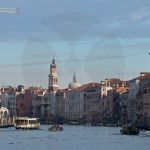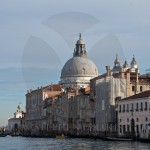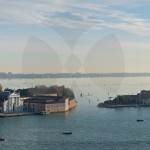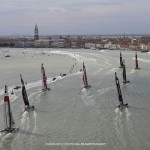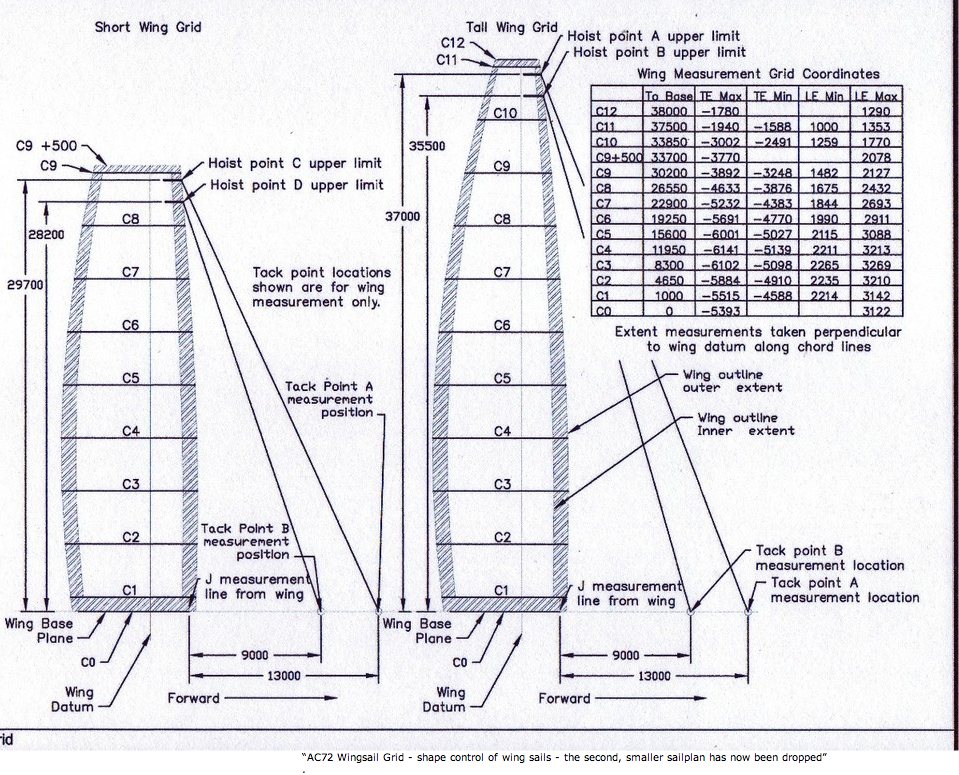Apart from the fact that both the 45 foot cats and the 72 foot cat are both catamarans. They are very different beasts.
Tag: America’s cup 34
AMERICA’S CUP IN VENICE
I cannot imagine a more spectacular setting for the kind of racing that is now the America’s Cup World Tour. Plymouth England must have been wonderful as from the Hoe one can look out with an unobstructed view. Fort Adams guarding the entrance to Narragansett Bay will provide a perfect stadium, but not much can compare to Venice.
I encourage you to click on the panorama which is a rather good view of the open water leading to the Grand Canal.
“EXPENSES SHOULD MATCH REVENUE”?
America’s Cup lays off 28 people, race officials say
The business arm of the America’s Cup laid off a quarter of its staff Friday, the latest sign the premiere sailing competition has dramatically scaled back its presence — and budget — in San Francisco.
The America’s Cup Event Authority laid off 28 people, 14 of them in the San Francisco office and the other 14 in offices around the world, race officials said. They worked in the information technology, marketing and communications departments.
The shake-up stemmed from the pared-down deal between the America’s Cup and the city to host the event this year and in 2013.
“We’re having expenses match the revenues as much as we can,” said Stephen Barclay, who took over as interim CEO for the event authority this week in another sign of reorganization. “And a number of people will be leaving as a result.”
Originally, the Event Authority was going to invest $111 million in infrastructure work to repair deteriorating piers the city has sought for decades to fix. But race officials backed away from that agreement earlier this month.
The new deal, set to be considered by the Board of Supervisors Tuesday, calls for the port to invest nearly $22 million in pier repairs, including up to $8 million for team bases at Piers 30-32. A team of fundraisers, meanwhile, is responsible for raising $32 million to cover the city’s costs to put on the event, and have so far raised $12.5 million, according to a city audit released Friday.
Beyond the rollback of the development deal, the event authority is also scaling back event facilities, including no longer trying to have any at Crissy Field, part of the Golden Gate National Recreation area.
“IT’S A FOLLY”
Grant Dalton has become the “Ted Turner” of modern sailboat racing. We all anticipate his next words. He shocks, surprises, and has a fresh plain spoken approach, that no matter how outrageous his statements might be; there is always a nugget of something we can relate to.
It his latest statement he says that if it were up to him, there would be a change of boats for the America’s Cup and has supporting evidence for his statement.
JUST ONE OF THE PROBLEMS
Yachting: Only three challengers means rethink of America’s Cup
5:30 AM Wednesday Feb 1, 2012
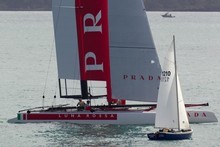
America’s Cup team Prada, Luna Rossa. Photo / Brett Phibbs.
The underwhelming number of entries for the 34th America’s Cup has forced organisers to re-think the format of next year’s regatta.
Just three challengers – Emirates Team New Zealand, Luna Rossa and Artemis – have paid the US$100,000 ($121,000) entry fee for the 2013 event. With those teams already well-advanced in the design and build process of their AC72s, America’s Cup regatta director Iain Murray admits it is looking increasingly unlikely that another syndicate will enter at this late stage.
“We’re hopeful of having more teams outside of the teams that are already building, but the reality is the runway is going to run out in the not too distant future as to when they can start building and get to the startline, so it is going to become clear pretty quickly as to who the Louis Vuitton Cup competitors are going to be,” said Murray, who was in Auckland yesterday for a competitor’s forum.
The number of entries are well down on what organisers had been predicting, with the proposed format of the Louis Vuitton challenger series allowing for eight challengers and scheduled to run for two months from July 4-September 1 next year.
But with only three competitors, the regatta is likely to be scaled back significantly.
“It’s going to change what’s on the table for sure,” said Murray when asked if the length of the Louis Vuitton series will be reduced.
“In the next few weeks we’ll start planning on a bunch of potential different formats as to what the Louis Vuitton Cup will look like. We’ll have to look at the mixture of the type of racing we do and how many races we do on each day and the breaks that we give the teams.”
Murray said he was aware of the importance of maintaining the history and heritage of the America’s Cup.
One of the options discussed yesterday was making each of the matches a best-of-three series rather than just a one-off match race.
This format could also be introduced for the America’s Cup World Series regattas this year.
But it is still not apparent how that would fit into an eight-week Louis Vuitton series, much to the frustration of the competing teams who are keen for clarity around this.
Murray said a number of different agendas were emerging in the competitors’ group, with some focused on AC45 issues, with the other four teams more interested in the AC72s.
For the AC72 group their main concerns yesterday were getting the length of course sorted, the format of the racing and the way the racing would be scored.
“What we’re seeing is a number of different agendas emerging and as we go forward we have a number of different subjects we need to deal with,” said Murray.
“The teams that are well-organised and strong are digging deeper into the detail of what we’re going to do.”
Controller: America’s Cup needs “significant additional fundraising”
The plan was to have $12 million raised a week ago to help cover the city’s costs for hosting the upcoming America’s Cup regatta.
LUNA ROSSA IS IN
Finally, there will be some style and likely good parties, good food as part of the America’s Cup. In sharp contrast, the freeze dried food is being loaded on the 6 Volvo 70’s which leave on the sixth for the first leg of the round the world race.
: www.americascupmedia.com
Luna Rossa and the Circolo della Vela Sicilia challenge for the 34th America’s Cup
Milan, Italy, 02/11/2011
***The following press release is being distributed on behalf of Luna Rossa Challenge 2013:
Luna Rossa and the Circolo della Vela Sicilia challenge for the 34th America’s Cup
Technical and sporting cooperation with Emirates Team New Zealand
The Circolo della Vela Sicilia of Palermo and the team Luna Rossa Challenge 2013 announce that their Notice of Challenge for the 34th America’s Cup, which will be held at San Francisco in September 2013, has been accepted by the Golden Gate Yacht Club.
Luna Rossa Challenge 2013 and Emirates Team New Zealand have signed a cooperation agreement until 31st December 2012 which includes full access to all ETNZ design and performance data for this period. The hulls for the Luna Rossa AC72’ will be built in Italy and all other elements will be built in New Zealand in close cooperation with Emirates Team New Zealand.
Luna Rossa’s 2012 programme includes the opening of a base in Auckland (New Zealand) for the joint training, the participation in all events of the America’s Cup World Series (ACWS) with the AC 45’ wing catamarans and the launch of the AC 72’ wing catamaran for the America’s Cup.
From March 2013 the team Luna Rossa will continue its sporting preparation and technical development of the AC 72’ in San Francisco and will participate to all events scheduled for the 34th America’s Cup.
PATRIZIO BERTELLI, Team Principal of Luna Rossa Challenge 2013, declared: “I am certain that the co-operation of Luna Rossa with Emirates Team New Zealand will produce excellent results, giving to both teams a faster and more effective development both in the technical and in the sporting fields. The choice of the Circolo della Vela Sicilia as challenging yacht club is also significant: I think it is important, in a moment like this, to underline the unity of our country also in the field of culture and sports”.
AGOSTINO RANDAZZO, President of the Circolo della Vela Sicilia, declared: “It is a true honour for the Circolo della Vela Sicilia to challenge for the America’s Cup with a prestigious and beloved team like Luna Rossa. I therefore thank Patrizio Bertelli both for having selected us and also for the reasons behind his choice. I am sure that our challenge will contribute to create a strong spirit of emulation and will attract many young Sicilians to the sport of sailing”.
MATTEO de NORA, Team Principal of Emirates Team New Zealand, declared:
“I am very happy of this co-operation: since 2000, when they won the Louis Vuitton Cup, Luna Rossa is certainly the most loved and respected foreign sailing team in New Zealand. This partnership will increase the technical value of the teams. We look forward to close co-operation on land and intense rivalry on the water.”
GRANT DALTON, managing director of Emirates Team New Zealand, said: “The cooperation with Luna Rossa is another step towards the long-term objective of establishing our team as a provider of technology and services that highlight New Zealand’s marine industry expertise. We look forward to sharing our design office resources and cooperating with two such well-respected names in top-level sailing.”
______________________
The team Luna Rossa was established in 1997 by Patrizio Bertelli with the original name of “Prada Challenge for the America’s Cup 2000”. At its first attempt the team wins the Louis Vuitton Cup – the challengers’ selection series – in 2000, with a record of 38 victories over 49 races. Luna Rossa has participated also in 2003 and in 2007 it reached the Louis Vuitton Cup final. Luna Rossa is currently participating in the Extreme Sailing Series, the Extreme 40’ catamarans circuit, where it is leading the overall standings.
Emirates Team New Zealand is the current holder of the Louis Vuitton Cup and is leading the America’s Cup World Series. Established in 1985 as the New Zealand Challenge, Emirates Team New Zealand has won both the America’s Cup twice and the Louis Vuitton Cup twice. It also participates in the Audi Med Cup and Extreme Sailing Series international racing circuits and will be at the start of the 2011/2012 Volvo Ocean Race with the yacht CAMPER.
The Circolo della Vela Sicilia, founded in 1933, is one of the oldest and most prestigious yacht clubs of the Mediterranean. Its club house is in Mondello, a few kilometres from the centre of Palermo. Throughout the years the Circolo della Vela Sicilia hosted many prestigious national and international regattas, including the J 24 and Star Class European Championships, the Italian Olympic classes Championship and the “Palermo – Monte Carlo” offshore race.
AMERICA’S CUP INSIDER
Keep up with the latest america’s cup
PIRATES AND NEW RULES
The electronic monitoring of the boats racing in the America’s Cup instead of judges in boats will changes yacht racing again. The America’s Cup seems determined to alter yacht racing as we have known it. Personally I have long wondered when we would have this sort of thing. GPS has become very accurate. Judges and the boats necessary have made match racing very labor intensive and expensive. We should be using this technology in all yacht racing. It would allow very accurate guidance in a protest hearing at the least.
It has also been announced that the solid wings for the 72 foot boats will be only the smaller version, not several as originally planned.
This is the light side of sailing. Four Americans were killed this week in a part of the world that has become famous for Pirates.
Even for modern Navy, no easy solution to piracy
WEDNESDAY, FEBRUARY 23, 2011 AT 9:38 P.M.
/ USS STERETT
The 509-foot Sterett steams off Point Loma during maneuvers in 2010. The destroyer is among the Navy’s newest ships, having been commissioned in 2008.
In the vast waters around the Gulf of Aden, roughly 1 million square miles of sea, finding pirates and rescuing their victims is something even today’s sophisticated, nuclear-power Navy can’t always do.
After Tuesday’s killing of four Americans aboard their hijacked yacht off the coast of Oman, Navy officials remained silent about whether the American deaths will prompt a change in tactics. Meanwhile piracy experts say bulking up the U.S. military presence or even attacking pirate dens in Somalia isn’t necessarily the long-term answer. Any solution must change what turns people into high-seas criminals, they said.
Navy ships steaming out San Diego, including the Boxer amphibious group on Tuesday, are increasingly listing anti-piracy as one of their top deployment missions. But they are finding themselves operating in a part of the world where the brigands are not ideology-driven terrorists or warriors, but desperate youths being controlled by businessmen hungry for multimillion-dollar ransoms.
“Everybody’s going to say now we’ve got to go in there guns blazing,” said retired Rear Adm. Terry McKnight, who commanded the Navy’s anti-piracy task force when it was launched in early 2009.
“But, first of all, nobody wants to go after the pirates ashore in Somalia. And the other thing is, it’s a criminal event. You have to fall under the guidelines of international justice,” McKnight said.
“If we had a 1,000 ship Navy to go out there, we’d make a major dent in piracy … but the problem is the area is so vast you can’t be everywhere.”
Last year was the worst on record for mayhem on the seas. Pirates captured 1,181 mariners and killed eight, hijacking more than 50 ships, according to the International Chamber of Commerce’s International Maritime Bureau.
The situation is most bleak off Somalia, which accounted for 92 percent of all ship seizures in 2010.
International attention, including the Navy’s now 2-year-old Combined Task Force 151 and two European task forces, has decreased attacks in the Gulf of Aden. Navy officials said there are 34 warships, under 15 different national flags, now patrolling the gulf area.
But the pirates are pushing farther out.
Tuesday’s killings were an example of the new pattern: Somali pirates used a “mother ship,” a larger vessel they’d hijacked earlier, as a base to extend their skiff attacks northward into the Arabian Sea.
The 58-foot yacht, carrying a Marina del Rey couple and their two friends, was trailed by four Navy ships, including the San Diego-based destroyer Sterett.
Negotiation with the pirates was attempted but ultimately failed to save the Americans, who were killed by the pirates. A team of Navy SEALs raced to cover the 600 yards between the Sterett and the yacht after pirates fired a rocket-propelled grenade at the destroyer.
To Tom Wilkerson, U.S. Naval Institute chief executive, that loss of life means current anti-piracy strategy isn’t working.
Differing from McKnight, he is in the camp that says follow the pirates onto land.
“Finding pirates in the act in that area is a dice roll,” said Wilkerson, a retired two-star Marine general.
“If the U.S. and the international community are serious about reducing the piracy, they need to engage using the UN resolutions to put some kind of force ashore and remove the sanctuary.”
The Sterett is only the most recent in a string of San Diego warships drawn into pirate-fighting.
In September, a platoon of Camp Pendleton-based Marines aboard the Dubuque rescued the crew of the German cargo ship Magellan Star.
In a mission that required a White House green light, 24 force reconnaissance Marines captured 9 Somali pirates and saved the crew that was hiding in a fortified part of the ship.
Capt. Alex Martin, who led that team, said the Somalis almost instantly dropped their earlier bravado when the first Marine appeared over the bow.
“You felt like they were criminals who had been caught. It wasn’t like dealing with elements of al Qaeda in Iraq, where this is what these guys do, they believe in this,” said Martin, 28, a La Jolla High School graduate. “These were just criminals. And once they got caught, they were like, ‘Oh, God, what now?'”
The San Diego-based destroyer Howard had its pirate encounter in September 2008, when it rushed across 350 miles of ocean to aide the Faina, a Ukrainian vessel carrying military weapons.
In the end, the ship’s owners declined to risk their cargo in a raid, instead paying the pirates a $3 million ransom six months later.
And, in one of the most high-profile actions of late, Navy SEAL snipers bobbing on the back of a destroyer shot pirates holding the captain of the American cargo ship Maersk Alabama at gunpoint in April, 2009.
It was that incident, and the later 33-year sentence handed to one of the pirates by a New York court, that may have intensified the peril on the seas.
The Associated Press on Wednesday quoted Somali marauders who vowed that they will kill hostages before being captured during military raids and facing trial.
It’s not the way this business used to work, piracy experts say.
Somali pirates were known for taking hostages and holding them, alive, for ransoms that have ballooned in recent years. A common demand in 2005 was $150,000 to $200,000. Now the stakes have risen to as high as $9 million per ship, said Martin Murphy, author of the new book “Somalia, the New Barbary? Piracy and Islam in the Horn of Africa.”
If the international community promoted some other way for ordinary people to make money, that pirate bounty might not look so attractive, Murphy said, as much of it flows to the ringleaders, not the people taking the risks.
For cargo shippers, the high-stakes gamble appears to make sense for now, said Peter Chalk, RAND Corp. analyst. Using the Suez Canal and the Gulf of Aden cuts travel time from the Mediterranean Sea to the Indian Ocean by three weeks, saving the shipping industry an estimated $2 billion a year or more.
Efforts to make ransom payments illegal have gone nowhere, Chalk said. If the United States wanted to change that, or rewrite current rules of engagement for Navy ships fighting pirates, the task would be difficult because these maritime polices are international in nature, he said.
Pleasure boaters used to be somewhat safe from Somali pirates, as they weren’t seen as rich ransom targets. That may explain why the Marina del Rey couple entered the area off Oman.
“I think here they weren’t expecting trouble because they were so far away from major concentration of attacks,” Chalk said.
As Wilkerson, the retired Marine general, said about U.S. policy toward pirates, that strategy may need to be reworked in the future.
AC 45 CATS
These 45 foot carbon fiber catamarans were launched from conception to on the water was only 4 months.
24 prospective teams?
Twenty-four prospective teams met in Paris to hear about the next America’s Cup. I am not sure anyone expected that many teams. Of Course no one knows how many teams will show up in the end. Given how many teams are European, it seems ever more difficult to see how San Francisco will be the venue. The audience is in Europe.
Esimit Europa 2 has rounded Lampedusa comfortably ahead of Leopard of London (both boats are older reichel pugh designs) heading for Malta

